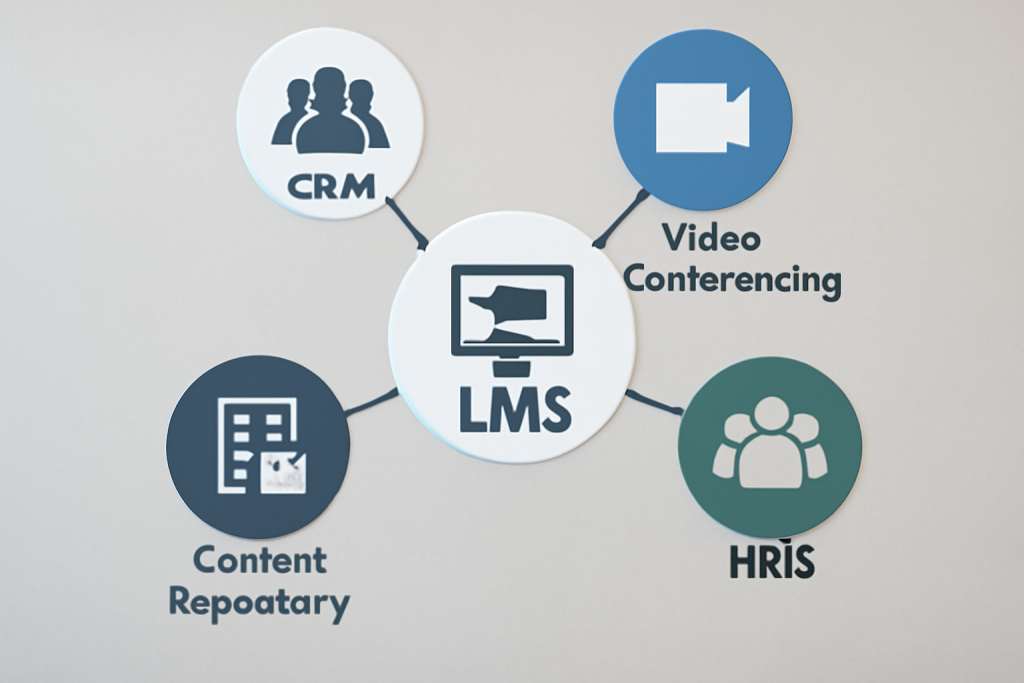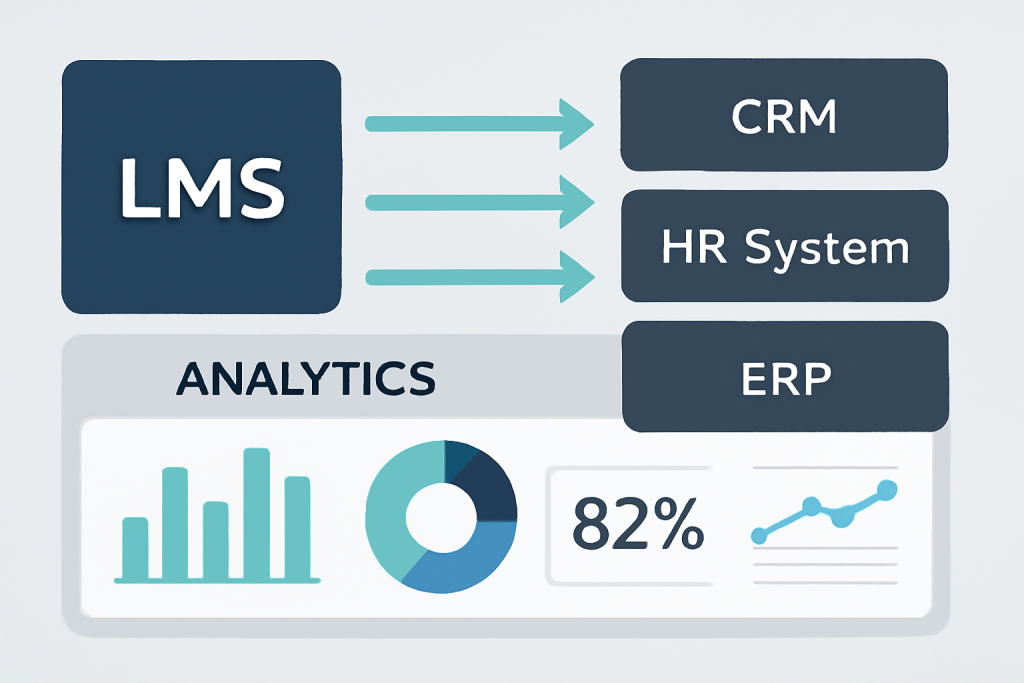LMS integration has become a critical component for organizations seeking to create seamless, efficient educational experiences. LMS integration services allow your Learning Management System to connect with other essential business systems, creating a unified digital ecosystem that enhances learning effectiveness and operational efficiency. This comprehensive guide explores what LMS integration services are, their benefits, implementation strategies, and emerging trends in 2025. Whether you’re a corporate training manager, educational institution administrator, or EdTech professional, understanding LMS integration will help you maximize your learning technology investments.

Table of Contents
Understanding LMS Integration in 2025
Definition and Core Components
LMS integration refers to the process of connecting your Learning Management System with other software applications to create a cohesive ecosystem where data flows seamlessly between systems. At its core, integration services involve establishing communication pathways between your LMS and other digital tools using various technical methods such as APIs (Application Programming Interfaces), webhooks, or middleware solutions.
Modern LMS integration services in 2025 typically include:
- Data synchronization capabilities that ensure information remains consistent across platforms
- Authentication mechanisms like Single Sign-On (SSO) for seamless user experience
- Content interoperability features that enable learning materials to be shared across systems
- Reporting bridges that consolidate analytics from multiple sources
According to recent industry data, organizations with integrated learning ecosystems report 47% higher training completion rates and 36% better knowledge retention compared to those using isolated systems.
Types of LMS Integration Services
In the current EdTech landscape, several types of LMS integration services cater to different organizational needs:
- Point-to-point integration – Direct connections between an LMS and another specific application
- Enterprise middleware integration – Using middleware platforms to facilitate connections between multiple systems
- API-based integration services – Leveraging standardized APIs for flexible, scalable connectivity
- Custom integration development – Bespoke solutions tailored to unique organizational requirements
- Integration Platform as a Service (iPaaS) – Cloud-based integration solutions that support multiple connection types
Recent trends show that API-based integration services have gained significant popularity, with over 68% of organizations preferring this approach in 2025 due to its flexibility and future-proof nature.
Key Benefits of LMS Integration Services
Streamlined Learning Management
Implementing robust LMS integration solutions delivers substantial efficiency improvements across your learning operations. By connecting your LMS with other business systems, you eliminate redundant data entry, automate administrative tasks, and create smooth workflows.
The tangible benefits include:
- Reduction in administrative workload by up to 65%
- Decreased training management time by approximately 40%
- Automated user provisioning and enrollment processes
- Simplified content management across platforms
Enhanced Data Analytics and Reporting
One of the most powerful advantages of modern LMS integration is the ability to consolidate and analyze learning data from multiple sources. This comprehensive view enables:
- Holistic performance tracking across the learning journey
- Correlation of learning outcomes with business metrics
- Real-time reporting dashboards with multi-system data
- More sophisticated ROI analysis of learning initiatives
Industry research from early 2025 indicates that organizations with integrated learning analytics experience a 52% improvement in their ability to make data-driven decisions about training investments.
Improved User Experience and Engagement
LMS integration services dramatically enhance the learner experience by creating intuitive, friction-free interactions. Key improvements include:
- Single sign-on capabilities eliminating multiple login requirements
- Consistent user interfaces across connected platforms
- Personalized learning paths based on data from multiple systems
- Seamless access to learning resources regardless of where they’re stored
These experience enhancements translate to measurable engagement improvements, with integrated learning ecosystems showing 43% higher learner satisfaction rates in recent studies.
Common LMS Integration Use Cases
Content Management System (CMS) Integration
Connecting your LMS with content management systems enables more efficient creation, storage, and deployment of learning materials. Benefits include:
- Centralized content repositories accessible from within the LMS
- Version control and content governance across platforms
- Simplified content updates that propagate automatically
- Consistent branding and formatting of learning materials
A significant trend in 2025 is the integration of AI-powered content management systems with LMSs to automatically tag, categorize, and recommend learning content based on metadata and user behavior.
Video Conferencing Tool Integration
The continued importance of virtual instructor-led training makes video conferencing integration essential. Modern LMS integration with platforms like Zoom, Teams, or Webex provides:
- One-click access to virtual classrooms from within the LMS
- Automatic scheduling and calendar synchronization
- Recording management and accessibility
- Attendance tracking and participation analytics
Recent statistics show that 78% of organizations now consider video conferencing integration a “must-have” feature when selecting an LMS.
Customer Relationship Management (CRM) Integration
Connecting your LMS with CRM systems creates powerful synergies for organizations focused on customer education or partner training:
- Automatic enrollment based on customer status or purchases
- Training progress visibility for sales and support teams
- Certification tracking linked to customer accounts
- Learning analytics that inform customer success strategies
Human Resource Information System (HRIS) Integration
HRIS integration remains one of the most valuable connections for corporate learning environments:
- Automated user provisioning based on employment status
- Synchronization of organizational structures and reporting relationships
- Compliance training management aligned with job roles
- Learning and development data incorporated into employee records
According to 2025 workforce development reports, organizations with integrated HRIS and LMS systems experience 33% faster onboarding times and 28% higher employee retention rates.

Technical Aspects of LMS Integration
API-Based LMS Integration
In 2025, API-based integration has become the gold standard for LMS integration services. Modern RESTful APIs offer:
- Standardized communication protocols between systems
- Granular control over data exchange
- Scalable architecture that supports growing needs
- Developer-friendly documentation and support
The most advanced LMS providers now offer comprehensive API libraries with over 200+ endpoints covering every aspect of the learning ecosystem.
Single Sign-On (SSO) Integration
SSO implementation has evolved significantly, with current solutions providing:
- Multiple authentication protocol support (SAML, OAuth, JWT)
- Enhanced security features including multi-factor authentication
- Customizable user attribute mapping
- Detailed access logging and security monitoring
Recent security studies indicate that proper SSO integration reduces credential-related security incidents by up to 56%.
Data Migration and Synchronization
Effective LMS integration requires robust data handling capabilities:
- Real-time vs. batch synchronization options based on business needs
- Conflict resolution mechanisms for data discrepancies
- Transformation mapping for different data formats
- Comprehensive error handling and notification systems
Latest integration platforms now leverage AI to detect and resolve data inconsistencies automatically, reducing manual intervention by approximately 70%.
Implementing LMS Integration: Step-by-Step Process
Planning and Requirements Gathering
Successful implementation begins with thorough planning:
- Identify all systems requiring integration with your LMS
- Document specific data flows and business processes
- Establish clear success metrics and performance expectations
- Gather technical documentation for all systems involved
- Define security and compliance requirements
Organizations that invest in proper planning report 42% fewer implementation issues and complete integrations 35% faster.
Selection of Integration Methods
Choosing the right integration approach depends on several factors:
- Available technical resources and expertise
- Budget constraints and timeline requirements
- Existing system capabilities and limitations
- Long-term scalability needs
- Vendor-provided integration tools vs. third-party solutions
When evaluating options, consider that while custom integrations offer maximum flexibility, they typically cost 3-5 times more than leveraging pre-built connectors.
Testing and Deployment
Thorough testing is critical for successful LMS integration:
- Create comprehensive test plans covering all integration points
- Perform sandbox testing before deploying to production
- Conduct end-to-end testing with actual user scenarios
- Validate data integrity across all connected systems
- Plan for phased rollout to minimize disruption
Industry best practices now recommend allocating 25-30% of the total integration project time specifically for testing.
Challenges in LMS Integration and How to Overcome Them
Data Security and Compliance Concerns
Integration introduces potential security considerations:
- Data exposure during transit between systems
- Compliance with regulations like GDPR, HIPAA, or industry-specific requirements
- Access control management across multiple platforms
- Audit trail requirements for sensitive information
To address these concerns, implement encryption for data in transit and at rest, conduct regular security audits, and ensure vendor compliance certifications are current.
Technical Compatibility Issues
Common technical challenges include:
- Legacy systems with limited integration capabilities
- API version conflicts and deprecation issues
- Performance bottlenecks during data synchronization
- Inconsistent data formats and structures
Overcome these by implementing middleware solutions where necessary, establishing clear API governance, and creating detailed integration documentation.
User Adoption Barriers
Even the best LMS integration can fail without proper adoption:
- Resistance to new workflows or interfaces
- Insufficient training on integrated features
- Lack of communication about integration benefits
- Performance issues affecting user experience
Address these challenges with comprehensive change management, targeted user training, and clear communication about how integration improves the learning experience.
Future Trends in LMS Integration (2025 and Beyond)
AI-Powered Learning Ecosystems
Artificial intelligence is transforming integrated learning environments through:
- Predictive analytics that forecast learning needs
- Intelligent content recommendations across integrated repositories
- Automated skill gap analysis linked to career development
- Natural language interfaces for accessing learning resources
By late 2025, analysts predict 65% of enterprise LMS implementations will incorporate some form of AI-powered integration.
Microservices Architecture for LMS
The architectural approach to LMS integration is evolving with microservices becoming dominant:
- Component-based integration replacing monolithic approaches
- Composable learning ecosystems with plug-and-play capabilities
- Reduced vendor lock-in through standardized interfaces
- Improved resilience and scalability of integrated systems
Organizations adopting microservices architecture report 47% faster deployment of new learning features and 39% lower maintenance costs.
Extended Reality (XR) Integration
The convergence of XR technologies with learning systems is accelerating:
- Seamless integration of VR/AR training modules with traditional LMS tracking
- XR content management capabilities within standard LMS interfaces
- Performance data collection from immersive learning experiences
- Multi-device XR delivery integrated with learning paths
The XR learning market is projected to grow by 36% annually through 2027, driving demand for sophisticated LMS integration services.
Choosing the Right LMS Integration Service Provider
Key Evaluation Criteria
When selecting an integration partner, assess:
- Technical expertise with your specific LMS and target systems
- Track record of successful similar integration projects
- Scalability of proposed solutions
- Support and maintenance capabilities
- Security practices and compliance certifications
Industry surveys indicate that 73% of organizations cite vendor expertise as the most critical factor in successful integration projects.
Questions to Ask Potential Providers
Before committing to an integration partner, ask:
- What experience do you have with our specific LMS platform?
- How do you approach data security during integration?
- What is your testing methodology for ensuring integration quality?
- How do you handle ongoing support and maintenance?
- Can you provide references from similar integration projects?
Conclusion: Maximizing Value from LMS Integration
LMS integration services have evolved from nice-to-have features to essential components of effective learning ecosystems in 2025. By connecting your learning management system with other critical business applications, you create a cohesive environment that improves efficiency, enhances the learning experience, and delivers measurable business impact.
As you consider implementing or expanding your LMS integration strategy, focus on your specific organizational needs, establish clear success metrics, and select partners with proven expertise in your technology stack. Remember that successful integration is an ongoing journey rather than a one-time project—continuous optimization based on user feedback and emerging technologies will ensure your learning ecosystem remains effective and future-proof.
Ready to transform your learning environment with powerful LMS integration? Contact Yuztech team today for a personalized consultation and discover how our integration services can help you build a seamless, efficient learning ecosystem tailored to your unique requirements.

